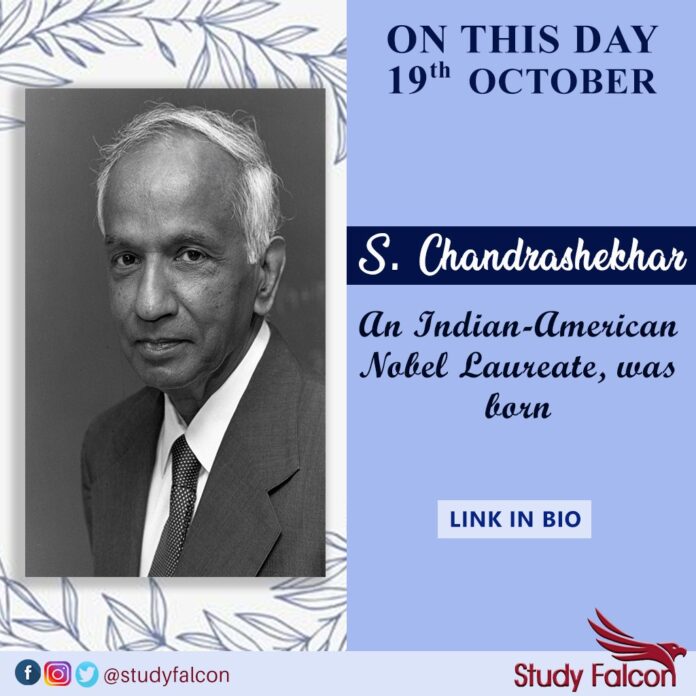Subrahmanyan Chandrasekhar FRS was an Indian-American astrophysicist who spent his professional life in the United States. He was awarded the 1983 Nobel Prize for Physics with William A. Fowler for theoretical studies of the physical processes of importance to the structure and evolution of the stars. He discovered that massive stars can collapse under their own gravity to reach enormous or even infinite densities. Today, we call these collapsed stars as the neutron stars and black holes.
Subrahmanyan Chandrasekhar was born on October 19, 1910 in Lahore, British India. As a young boy, he was home-schooled by his parents and private tutors. Chandrasekhar was educated at Presidency College, at the University of Madras, and at Trinity College, Cambridge.
In 1929, aged 18, he wrote his first academic paper, The ‘Compton Scattering and the New Statistics’. The following year, he graduated with a B.Sc. Honors degree in physics.
From 1933 to 1936 he held a position at Trinity. Chandrasekhar was the nephew of C.V. Raman, who won the Nobel Prize for Physics in 1930.
Between the ages of 18 and 28 (1929 to 1939) Chandrasekhar was intensely interested in the physics of stars – astrophysics. Traveling by ship in 1930 to begin his Ph.D. at Cambridge, he calculated a number. In his honor this number is now called The Chandrasekhar Limit. Its value is 1.4.
Chandrasekhar determined what is known as the Chandrasekhar limit—that a star having a mass more than 1.44 times that of the Sun does not form a white dwarf but instead continues to collapse, blows off its gaseous envelope in a supernova explosion, and becomes a neutron star. Chandrasekhar came up with the idea for a limit on his voyage to England in 1930. However, his ideas met strong opposition, particularly from English astronomer Arthur Eddington, and took years to be generally accepted. Chandrasekhar published his result in 1931 in the Astrophysical Journal.
Chandrasekhar did not propose the existence of neutron stars or black holes, but in 1932 he wrote that for all collapsing stars of mass higher than the (Chandrasekhar) limit, there were no known forces that could prevent a singularity forming. For physicists, a singularity is a point with zero volume into which a star’s entire mass has been crushed by gravity. Today we know all black holes have a singularity at their centers.
Chandrasekhar joined the staff of the University of Chicago, rising from assistant professor of astrophysics (1938) to Morton D. Hull distinguished service professor of astrophysics (1952), and became a U.S. citizen in 1953.
In 1952, he became managing editor of the Astrophysics Journal, remaining in this highly demanding role until 1971, building it from a rather small publication into the foremost international journal of astrophysics.
He did important work on energy transfer by radiation in stellar atmospheres and convection on the solar surface. He also attempted to develop the mathematical theory of black holes, describing his work in The Mathematical Theory of Black Holes (1983).
In 1983, Chandrasekhar was awarded the Nobel Prize in physics “for his theoretical studies of the physical processes of importance to the structure and evolution of the stars.” He shared the prize with William Fowler.
Chandrasekhar was awarded the Gold Medal of the Royal Astronomical Society in 1953, the Royal Medal of the Royal Society in 1962, and the Copley Medal of the Royal Society in 1984. His other books included An Introduction to the Study of Stellar Structure (1939), Principles of Stellar Dynamics (1942), Radiative Transfer (1950), Hydrodynamic and Hydromagnetic Stability (1961), Truth and Beauty: Aesthetics and Motivations in Science (1987), and Newton’s Principia for the Common Reader (1995).
Subrahmanyan Chandrasekhar died of a heart attack on August 21, 1995, aged 84. He had retired from his role as a full professor at the University of Chicago in 1980. He continued living in Chicago and his output of scientific books continued. His final book was Newton’s Principia for the Common Reader, a masterpiece published shortly before his death. He was survived by his wife Lalitha, who died in 2013 at the age of 102.
It is now accepted that the ultimate fate of stars depends on their masses. Smaller stars become white dwarfs, while larger stars, after a supernova, can become neutron stars or black holes.
Today, NASA’s Chandra X-ray observatory, named in his honor, orbits the earth. This observatory has lived up to its name, discovering new black holes, new supermassive black holes, and a new class of black hole.










